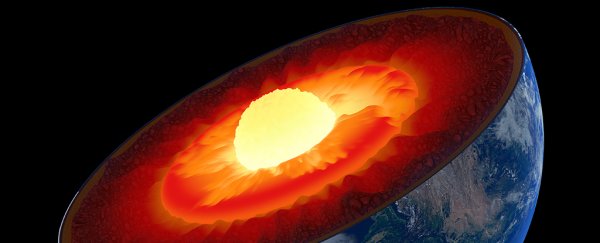Changes in the flow of iron around Earth's outer core are thought to contribute to very small fluctuations in the length of our days.
Now researchers say the sloshing of our planet's core could also be used for potential earthquake warnings, possibly even years ahead.
You've probably never noticed variations in the length of a day, as they're measured in milliseconds, but they represent very slight slowdowns in the speed that the world is spinning at.
Two geophysicists have found a correlation between day length variations over the last 100 years and major magnitude 7 earthquakes. They think the same root cause could be behind both - that molten iron sloshing around in Earth's core.
If the hypothesis holds up, we have a new earthquake predictor that could give us as much as five years of advance warning about the risk of increased tremors - way more warning than what we have right now.
"The Earth offers us a five-year heads up on future earthquakes, which is remarkable," suggests one of the researchers, Roger Bilham from the University of Colorado (CU) in Boulder.
"The correlation they've found is remarkable, and deserves investigation," Peter Molnar from CU, who wasn't involved in the study, told Paul Voosen at Science.
No one's quite sure how this sloshing action works, though it also affects slight changes in Earth's magnetic field as well as day length, so we know it's happening.
One idea is that part of the molten outer core sticks to the mantle above, changing the flow of liquid, and checking Earth's momentum - it's a bit like a loose cannon rolling across the deck of a ship, suggest the researchers.
In a study published in August, Bilham and Rebecca Bendick from the University of Montana found clusters of serious earthquakes happening at roughly 32-year intervals. In their latest work, they've also matched those clusters with peaks in the fluctuation in day lengths - and so maybe also with activity deep within Earth.
With Earth spinning at some 465 metres (1,509 feet) per second, the researchers say some kind of sloshing action could plausibly trigger a season of earthquake activity.
In fact, since 1900, more than 80 percent of all earthquakes measuring a magnitude 7 or above on the eastern Caribbean plate boundary have occurred within five years of one of these changes in Earth's speed and day length, including the 2010 Haiti earthquake.
It's still early days for the hypothesis, but having five or six years advance warning of increased earthquake risk could make a big difference to preparations, and other experts are cautiously optimistic.
"I've worked on earthquakes triggered by seasonal variation, melting snow," Michael Manga of the University of California, Berkeley, told Science. "[This] correlation is much better than what I'm used to seeing."
If molten core activity some 2,900 kilometres (1,802 miles) underground is indeed triggering significant earthquakes, the next few years should help to prove it.
We should be looking at between 17-20 heavy quakes per year from 2018, if the core sloshing and day length idea is correct.
"The year 2017 marks six years following a deceleration episode that commenced in 2011," write the researchers, "suggesting that the world has now entered a period of enhanced global seismic productivity with a duration of at least five years."
The research has yet to be peer-reviewed, but has been presented at the annual meeting of the Geological Society of America.
